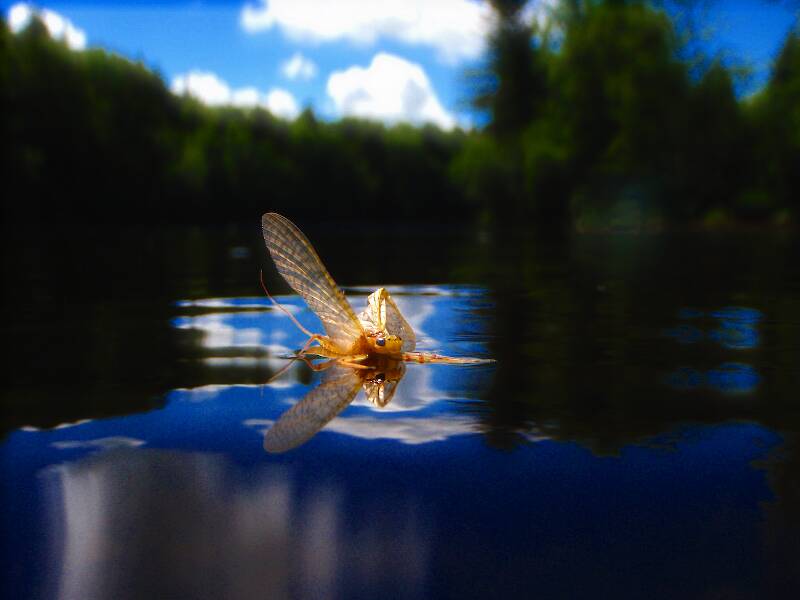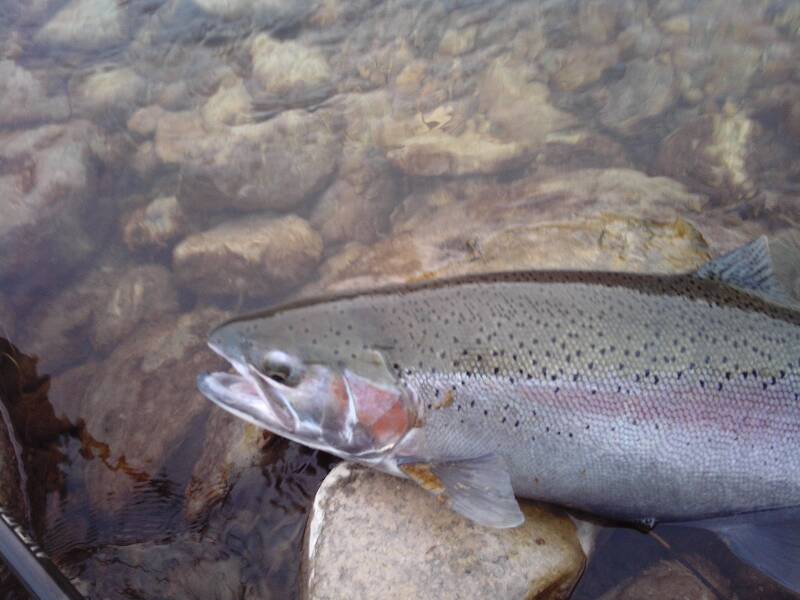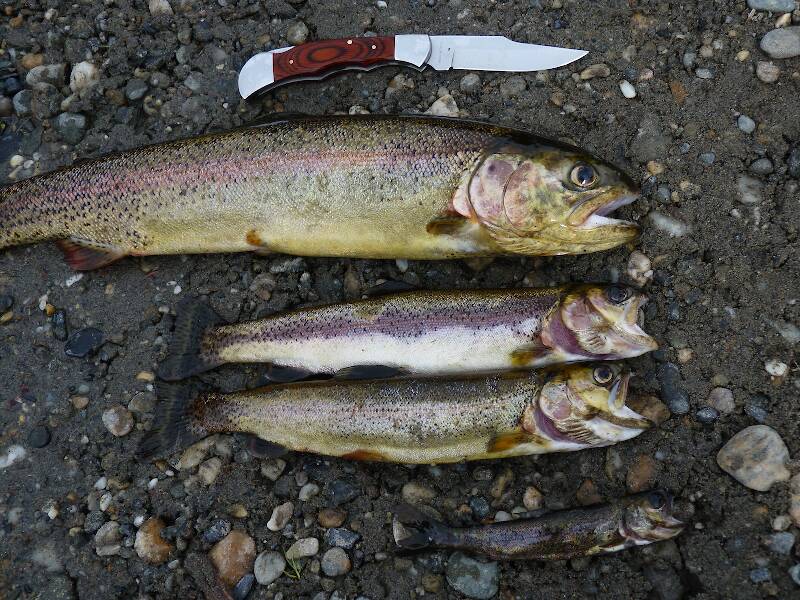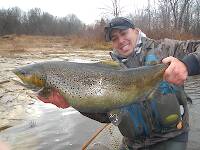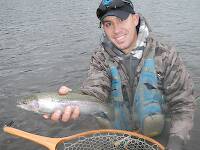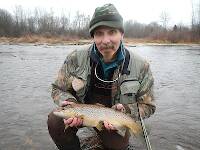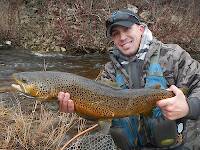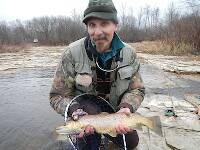
Salmonflies
Pteronarcys californica
The giant Salmonflies of the Western mountains are legendary for their proclivity to elicit consistent dry-fly action and ferocious strikes.
Featured on the forum

This specimen keys pretty easily to Onocosmoecus, and it closely resembles a specimen from Alaska which caddis expert Dave Ruiter recognized as this genus. As with that specimen, the only species in the genus documented in this area is Onocosmoecus unicolor, but Dave suggested for that specimen that there might be multiple not-yet-distinguished species under the unicolor umbrella and it would be best to stick with the genus-level ID. I'm doing the same for this one.

Troutnut is a project started in 2003 by salmonid ecologist Jason "Troutnut" Neuswanger to help anglers and
fly tyers unabashedly embrace the entomological side of the sport. Learn more about Troutnut or
support the project for an enhanced experience here.
Al514 on Aug 20, 2007August 20th, 2007, 2:07 am EDT
I have noticed that most browns have the black and red spots with the blue-ish halo around them, but some browns only have the black spots. I have only seen the difference in bigger trout and was wondering if its something they grow out of, or if it just a genetic difference? Maybe a subspecies or something? Just curious, thanks.
Shawnny3 on Aug 20, 2007August 20th, 2007, 2:38 am EDT
Too bad Gonzo's not here - I've never seen anyone take so much interest in the coloration of fish and the history and evolution of subspecies. I know he'd give you a great explanation (he goes into it to some extent in the first few chapters of his book).
I'm sure there are others (David?) out there who could also help you. But not I. Sorry.
-Shawn
I'm sure there are others (David?) out there who could also help you. But not I. Sorry.
-Shawn
Jewelry-Quality Artistic Salmon Flies, by Shawn Davis
www.davisflydesigns.com
www.davisflydesigns.com
Wbranch on Aug 20, 2007August 20th, 2007, 3:16 am EDT
It may be dependent on where the brown trout is caught. I have a picture of a 23" female I caught last year that has only black spots and a picture of a 21" male I caught last week that has black and red spots and blue halos around the red spots.
Catskill fly fisher for fifty-five years.
Jmd123 on Aug 20, 2007August 20th, 2007, 4:30 am EDT
The fact of the matter is, brown trout are extremely variable. This is likely due to genetics - browns were introduced to North America on more than one occasion - as well as diet and stream chemistry. The most colorful browns I have ever caught were in a very small, spring-fed stream in northern MI that also had a cosiderable brookie population. The brownies didn't get very big, though you might see the occasional 15-16-incher that looked like a submarine in those skinny waters! Since I didn't get many big ones out of there, I can only vouch for the little guys. These fish had the most beautiful crimson borders on ALL of their fins - in fact, their adipose fins were COMPLETELY red! I've never seen brownies of any size that had such crisp, vibrant colors on them. The brookies were pretty amazing, too - like little jewels.
For the genetic variability of Salmo trutta, check out James Prosec's Trout of the World. I never knew they came in so many different sizes, shapes, and colors!
Jonathon
For the genetic variability of Salmo trutta, check out James Prosec's Trout of the World. I never knew they came in so many different sizes, shapes, and colors!
Jonathon
No matter how big the one you just caught is, there's always a bigger one out there somewhere...
Wbranch on Aug 20, 2007August 20th, 2007, 5:09 am EDT
Catskill fly fisher for fifty-five years.
Jmd123 on Aug 20, 2007August 20th, 2007, 6:14 am EDT
That looks pretty typical for most of the browns I have caught.
Jonathon
Jonathon
No matter how big the one you just caught is, there's always a bigger one out there somewhere...
Smallstream on Aug 20, 2007August 20th, 2007, 7:14 am EDT

sorry that the picture is kind of poor, but this is probably the most unique looking brown I have caught, from a freestoner it seems that it is literally brown, and the red spots seem more apparent. I have caught some browns in spring creek though that had zero red spots, I might have a picture, but i think that these fish are hatchery escapees. the pic that westbranch posted seems to be what we are used to seeing when catching brown trout, the classic coloring I guess. Its kind of cool to see all of the different colorations.
Softhackle on Aug 20, 2007August 20th, 2007, 8:33 am EDT
While I'm no expert in genetics, there may have been, over the years, changes made to the original strains of brown trout originally brought here from Germany. These genetic changes may, indeed, be man-produced through breeding in the hatcheries and or through cross genetically altering to improve the strain in some way shape or form. Habitat and food can also influence the spotting of the fish. They are, as far as I know, all considered Salmo trutta.
The first importation of Brown Trout to the USA occurred in 1883 in New York and Michigan. These were imported from Germany, although there are other places that the browns were imported from, mainly Loch Leven. The browns original range was, mostly eastern Europe and the British Isles, Norway, Sweden, France, Germany, Austria, to Yugoslavia and tribs of the Caspian Sea; across Russia to Asia and on the very edge of the Himalayas; into Spain and across the Mediteranean to the northern Atlas streams of Algeria and Morocco.
Mark
The first importation of Brown Trout to the USA occurred in 1883 in New York and Michigan. These were imported from Germany, although there are other places that the browns were imported from, mainly Loch Leven. The browns original range was, mostly eastern Europe and the British Isles, Norway, Sweden, France, Germany, Austria, to Yugoslavia and tribs of the Caspian Sea; across Russia to Asia and on the very edge of the Himalayas; into Spain and across the Mediteranean to the northern Atlas streams of Algeria and Morocco.
Mark
"I have the highest respect for the skilled wet-fly fisherman, as he has mastered an art of very great difficulty." Edward R. Hewitt
Flymphs, Soft-hackles and Spiders: http://www.troutnut.com/libstudio/FS&S/index.html
Flymphs, Soft-hackles and Spiders: http://www.troutnut.com/libstudio/FS&S/index.html
RleeP on Aug 20, 2007August 20th, 2007, 11:47 am EDT
The BT picture Smallstream posted upthread is a ringer for I can't tell you how many wild browns of similar size I've caught in somewhat infertile smaller PA mountain streams.
There are browns in the small tribs of lower Penns that look just like that. As do browns from some of the small creeks that come off the flanks of the Bald Eagle and run to the Little J or the Big Bald Eagle. As do browns from some of the tribs of Big Pine, the Driftwood Branch and a dozen others.
My vote is that at least some of the coloration in these particular fish is habitat-influenced as much if not more than gentically influenced. And I also believe for the most part (dependent upon location) that they arew wild fish.
There are browns in the small tribs of lower Penns that look just like that. As do browns from some of the small creeks that come off the flanks of the Bald Eagle and run to the Little J or the Big Bald Eagle. As do browns from some of the tribs of Big Pine, the Driftwood Branch and a dozen others.
My vote is that at least some of the coloration in these particular fish is habitat-influenced as much if not more than gentically influenced. And I also believe for the most part (dependent upon location) that they arew wild fish.
Billfisher on Aug 20, 2007August 20th, 2007, 1:23 pm EDT
In SE Pennsylvania in Lower Allen Township is a brook named "Cedar Run". In the 1920's it was stocked with the Loch Leven strain brown stout, supposedly for a fishing trip by President Hoover, who never showed up.
The above was reported by the late Charlie Fox, who fished the stream often and wrote about it.
Years ago I lived on that stream and caught the descendants of those trout. They had exclusively red spots. Real good fish!
Bill
The above was reported by the late Charlie Fox, who fished the stream often and wrote about it.
Years ago I lived on that stream and caught the descendants of those trout. They had exclusively red spots. Real good fish!
Bill
Al514 on Aug 20, 2007August 20th, 2007, 4:00 pm EDT
how do I post pictures in my post?
Martinlf on Aug 20, 2007August 20th, 2007, 5:17 pm EDT
Many red spotted browns in the US descended from the German strain, Von Behr. The black spotted strain are Loch Levens, from Scotland. Color variations due to environmental conditions and the mixing of various strains can be found. Gonzo's book explains the two basic strains.
"He spread them a yard and a half. 'And every one that got away is this big.'"
--Fred Chappell
--Fred Chappell
Softhackle on Aug 21, 2007August 21st, 2007, 2:41 am EDT
Hi Louis,
I agree with the sources and descriptions you have posted, however, I have read that they are, in fact, the same fish "Salmo trutta". I am not a taxonomist, however the designation between Loch Leven and German trout was based more on where they were imported from. I've also read that for a long time, there was a number of different 'sub-species" designated, which is probably why there was so much confusion as to the true identity of the brown. It is my understanding that modern taxonomists consider them all one strain-- Salmo trutta.
I've also read that when Loch Leven Trout were stocked in Madras (India) in 1868 they developed the red spots of the so-called German Browns. To me, this would indicate that habitat greatly influences their coloration and spotting and that the nomenclature is based on where the trout were located rather than upon a different strain or sub-species.
Perhaps I'm incorrect in this, and perhaps Lloyd might, at some point in time, be able to shed more light upon his information. I'd love to find out.
Mark
I agree with the sources and descriptions you have posted, however, I have read that they are, in fact, the same fish "Salmo trutta". I am not a taxonomist, however the designation between Loch Leven and German trout was based more on where they were imported from. I've also read that for a long time, there was a number of different 'sub-species" designated, which is probably why there was so much confusion as to the true identity of the brown. It is my understanding that modern taxonomists consider them all one strain-- Salmo trutta.
I've also read that when Loch Leven Trout were stocked in Madras (India) in 1868 they developed the red spots of the so-called German Browns. To me, this would indicate that habitat greatly influences their coloration and spotting and that the nomenclature is based on where the trout were located rather than upon a different strain or sub-species.
Perhaps I'm incorrect in this, and perhaps Lloyd might, at some point in time, be able to shed more light upon his information. I'd love to find out.
Mark
"I have the highest respect for the skilled wet-fly fisherman, as he has mastered an art of very great difficulty." Edward R. Hewitt
Flymphs, Soft-hackles and Spiders: http://www.troutnut.com/libstudio/FS&S/index.html
Flymphs, Soft-hackles and Spiders: http://www.troutnut.com/libstudio/FS&S/index.html
TrevorC on Aug 22, 2007August 22nd, 2007, 9:49 am EDT
Fishing many different streams in Northern Michigan, you can catch a brown in one creek or river, drive 3 miles to a different creek, and the browns in that creek look entirely different (shape, color, markings, etc.)
I believe there are many different strains/species of brown trout. I believe that many different species change with their environment and diet.
Same scenario as mentioned above:
I took a friend of mine trout fishing for the very first time. I did not want to frustrate this friend of mine with a fly rod his first time out, so I took him "Tube dunking" - as we call it around here (worm, barbless hook, no weight, toss it in the river or creek on the upstream side, and let it drift under the road through the tube. Click the bail shut, wait 3 or 4 seconds, then reel in slowly until you feel the fish). I wanted him to just feel the electric shock shoot up his arm and into his heart as he felt his first trout. I had been trying to get this person to go trout fishing for years.
The first fish my friend caught was vibrant in color, many spots, slim and slender body size, although the fish was a nice 14 inches long. The creek he caught it in was crystal clear and ice cold. The second fish he caught was a smaller creek 3 miles down the road. The creek was a little darker in color with a marrow bottom. I had the hardest time convincing him to float his worm through the little 14" diameter tube. He thought there was no way a fish would be hiding inside that tube inside this little, muddy, tiny creek.
The fish he pulled out of the tube took 5 minutes to land, and was approx. 21 inches long. The brown trout was brown almost black in color. The spots were a different color and barely recognizable (hardly any red spots at all) The fish was blocky / chunky in body size, it almost looked like a different species of trout altogether.
I have noticed many different creeks/rivers that the fish look a little different from place to place from Tennessee to Michigan.
I believe there are many different strains/species of brown trout. I believe that many different species change with their environment and diet.
Same scenario as mentioned above:
I took a friend of mine trout fishing for the very first time. I did not want to frustrate this friend of mine with a fly rod his first time out, so I took him "Tube dunking" - as we call it around here (worm, barbless hook, no weight, toss it in the river or creek on the upstream side, and let it drift under the road through the tube. Click the bail shut, wait 3 or 4 seconds, then reel in slowly until you feel the fish). I wanted him to just feel the electric shock shoot up his arm and into his heart as he felt his first trout. I had been trying to get this person to go trout fishing for years.
The first fish my friend caught was vibrant in color, many spots, slim and slender body size, although the fish was a nice 14 inches long. The creek he caught it in was crystal clear and ice cold. The second fish he caught was a smaller creek 3 miles down the road. The creek was a little darker in color with a marrow bottom. I had the hardest time convincing him to float his worm through the little 14" diameter tube. He thought there was no way a fish would be hiding inside that tube inside this little, muddy, tiny creek.
The fish he pulled out of the tube took 5 minutes to land, and was approx. 21 inches long. The brown trout was brown almost black in color. The spots were a different color and barely recognizable (hardly any red spots at all) The fish was blocky / chunky in body size, it almost looked like a different species of trout altogether.
I have noticed many different creeks/rivers that the fish look a little different from place to place from Tennessee to Michigan.
I'll see you down on the river...
Fishfins on Jan 8, 2012January 8th, 2012, 11:30 am EST
here in lake huron we have lake browns and river browns (german brown trout) these fish have the yellow belly and dominate spots and the lake browns if u look really close at them they have x spots on them! hope this helps !
Doublespey
Posts: 61
Posts: 61
Doublespey on Jan 8, 2012January 8th, 2012, 11:43 am EST
I'm of the martinif description school. Those are the two subspecies I have heard mentioned. I also believe the anadromous Browns are the same fish as the Atlantic Salmon...can only be a DNA difference.
Fishfins on Jan 8, 2012January 8th, 2012, 4:31 pm EST
inever knew that i have only seen the x spots on the smaller ones the bigger browns that i have caught have the regular spots ! So would these x spot browns would they be inter spawning with atlantics because there is a few in the system and the ministry is trying to stock them but they are not showing up to any of our rivers ! would they be spawning along the lakeshore with some browns?
GldstrmSam on Jan 8, 2012January 8th, 2012, 8:51 pm EST
I not sure but could it have anything to do with cross breeding with other species. Or do they do that.
Sam
Sam
There is no greater fan of fly fishing than the worm. ~Patrick F. McManus
Oldredbarn on Jan 9, 2012January 9th, 2012, 9:51 am EST
Atlantic Salmon
The Alantics are anadromus and spend some time "at sea" and return to the streams to mate.
I think the ones with the x's are the Loch Leven strain of Brown.
Spence
"Even when my best efforts fail it's a satisfying challenge, and that, after all, is the essence of fly fishing." -Chauncy Lively
"Envy not the man who lives beside the river, but the man the river flows through." Joseph T Heywood
"Envy not the man who lives beside the river, but the man the river flows through." Joseph T Heywood
Doublespey
Posts: 61
Posts: 61
Doublespey on Jan 9, 2012January 9th, 2012, 12:32 pm EST
Oldredbarn..True, but there are anadromus browns. If you look at an anadromus brown and an Atlantic that have both been in the river for awhile physically looking they are identical. I've called around on this one, and had a pretty reliable source say they both inhabit the same waters, and have but a DNA difference. If true, wonder what subspecies the anadromus browns came from?
Quick Reply
Related Discussions
Topic
Replies
Last Reply


